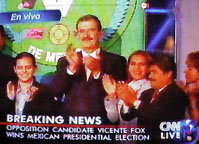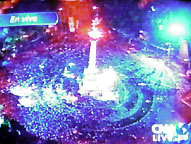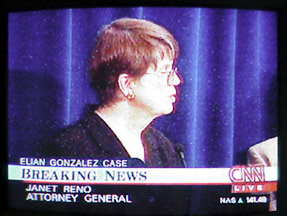
Televised debate among Mexican presidential candidates

Zapatistas in Chiapas, Mexico
Watching Television
World News
in Latin America
 Televised debate among Mexican presidential candidates |
 Zapatistas in Chiapas, Mexico |
What is news? The Webster dictionary says --- 1. new information about anything; information previously unknown; 2. a) reports, collectively, of recent happenings, esp. those broadcast over radio or TV, printed in a newspaper, etc. b) any person or thing thought to merit special attention in such reports. This note will deal with televised news.
It is common to classify news into local/national news versus international news. This dichotomy may be the result of a television station having two distinct services --- a purely local news program that it produces and an imported international news program. This note will deal with televised international news. When we examine the content of these programs, we think that it would be fair to say that a large portion of the time is devoted to politics (e.g. elections, meetings among heads of state, war and peace, etc). This is based upon the belief, rightly or wrongly, that politics is what moves the world.
Apart from professional politicians, many people are interested in world politics. In a global economy, what happens in one place may have significant impact elsewhere. For example, the 1999 currency devaluation and recession in Brazil was in fact triggered by a default of some Russian bonds, whereupon many large investors pulled back from ALL developing countries. Unless one is interested and well-informed, world news seems to be quite boring with morsels of digested information being meted out at a rapid pace. But with the development and deployment of media technology and the competition between television networks, there are now many more high-quality, in-depth news reports (for example, the complete coverage of the debates among the Mexican presidential candidates in 2000).



We are interested in the audience for world news in Latin America. According to the 1998 Los Medios y Mercados de Latinoamérica study, 21.5% of Latin Americans between the ages of 12 and 64 years old say that they watch television programs about world news/politics regularly.
|
Demographic Characteristics |
% watched televised world news/politics regularly |
| Sex Male Female |
22.9% 20.2% |
| Age 12-17 years old 18-24 years old 25-34 years old 35-44 years old 45-54 years old 55-64 years old |
11.9% 19.4% 20.8% 25.5% 30.0% 27.4% |
| Region Argentina Brazil Chile Colombia Mexico Venezuela Balance of Central America/Caribbean Balance of South America |
23.3% 21.0% 19.4% 19.2% 23.2% 27.0% 22.5% 17.5% |
| Occupation Owner/Manager Professional |
35.9% 34.0% |
| Number of years of education Less than 6 years Six years of more, but less than 12 years 12 years or more |
17.2% 19.0% 29.3% |
| Highest educational degree earned High school diploma Licenciatura Masters Doctorate |
28.9% 42.6% 44.8% 60.9% |
| Socio-economic
Level Level A (Top 10%) Level B (Next 20%) Level C (Next 30%) Level D (Bottom 40%) |
29.6% 24.9% 22.6% 16.9% |
| High technology elite | 28.3% |
| Multichannel television (cable/satellite/MMDS) | 22.5% |
| Psychographic
Segments Global Professionals Curious Cosmopolitans Image Seekers Concerned Traditionalists Comfortable Conservatives |
26.9% 24.0% 17.8% 19.4% 19.6% |
| TOTAL | 21.5% |
(Source: Los Medios y Mercados de Latinoamérica 1998)
We characterize the regular viewers of televised world news/politics as more likely to be
- male
- older (35 years or older)
- professional/managers by occupation
- better educated
- affluent
Most broadcast television channels can afford at most just a couple of hours of news coverage each day. Furthermore, large parts of the news programs are devoted to local topics, which are of greater immediate concern to viewers. Therefore, as much as someone is interested in world news, there may not be much available on the broadcast spectrum. An additional consideration is that national media have not always been trustworthy.
The dreams of news addicts were fulfilled with the introduction of cable/satellite television, with its offering of dozens of niche channels. One obvious niche would be news coverage. The demographic characteristics of this audience are also very attractive to advertisers. There is an economy of scale in developing global news networks that obtains news from and distributes the signals to all over the world. Presently, in Latin America, there are four pan-regional news networks in additional to a number of national ones which are typically allied with newspapers or new agencies. In the following table, we show that people who watch these channels are more likely to be regular viewers of world news/politics.
|
Viewed cable network in last 7 days |
% watched televised world news/politics regularly |
| Cable Network CBS Telenoticias CNNI CNN en Español ECO |
34.6% 24.4% 31.4% 33.7% |
| TOTAL | 21.5% |
(Source: Los Medios y Mercados de Latinoamérica 1998)
The media have a couple of important functions in the democratization process: dissemination of information and political mobilization. But these functions are double-edged swords because the media can either empower the electorate or they can be cynically used as the means to manipulate public sentiments. The media, especially television, wield a tremendous amount of influence. They can be coerced by official pressure, and their support can also sometimes be bought, legally through the direct purchase of commercial time or surreptitiously through payoffs to provide favorable coverage and editorial opinion. But the media effects are not straightforward, as sometimes attempts at harnessing the media can backfire in quite unexpected ways. Skidmore (see reference at the bottom of this page) provides this interpretation of the 'lavishly financed 1989 presidential campaign of the novelist Mario Vargas Llosa in Peru':
One of Latin America's most glamorous cultural figures, with best-selling novels translated in Europe and North America, Vargas Llosa emerged as the darling of the neoliberal right in Peru when the disastrous presidency of Alan Garcia was drawing to a close. Vargas Llosa's well-heeled campaign hired a leading U.S. campaign consulting firm, which saturated Peruvian television with spots featuring the elegant Vargas Llosa as the country's political savior. But the campaign backfired. The novelist's huge lead in the polls began to melt away as the public saw an ultrawhite, handsomely attired figure who came across as the incarnation of an aristocratic elite that had long dominated a country inhabited largely by native Americans and persons of mixed ancestry (mestizos).
The effect was so disastrous that Vargas Llosa, widely touted as a virtual shoo-in for the presidency, was forced to withdraw from the race. Seldom had Peruvian politics seen a candidacy so rapidly destroyed. And yet Vargas Llosa had been the candidate tailor-made to Washington's taste: committed to the neoliberal dogmas of privatization of state enterprises, extreme openness to foreign capital, embrace of free trade doctrines, and so forth. Furthermore, his rich supporters had brought in the finest U.S. media wizards. If the traditional leftist critique of mass media at the service of imperialism were to be believed, Vargas Llosa should have won. Instead, the unintended consequences of this use of that medium returned him to exile in London. (p.8-p.9)
In countries in which democratization is still nascent, the influx of international television news, especially through the cable/satellite channels, is supposed to provide templates and role models of democracy. Again, the effects may not always straightforward as intended. What is celebrated in some countries as examples of democratic rule may be regarded with dismay and distaste as examples of moral degeneration and disrespect. What, for example, do we suppose Latin Americans must think about .the following story ... ?
 |
 |
![]()
CABLE/SATELLITE NEWS CHANNELS
BOOK REFERENCES
(posted by Roland Soong on 6/18/00)
(Return to Zona Latina's Home Page)